

Libratone Track+: A versatile headphone with impact
The Track+ from Libratone comes as in-ear headphones with multi-stage noise cancelling and an eye-catching cable. Libratone gets a lot of things right. The customisable noise cancelling in particular promises a lot. I tested the headphones in everyday use.
At first glance, the latest headphones from Libratone look like sports headphones. This is because they come with a stiffened and bulky-looking neck cable. At second glance, however, it becomes clear that the Track+ is much more finely built than a sports headphone and is not just for sports. It's a pair of headphones that you can use in almost any situation. That's one of the reasons why I liked the Track+ so much.
The Danish manufacturer has only been involved in the audio market for ten years. However, Libratone quickly became known for its simple designs and good sound quality. The fact that noise cancelling with four different levels is possible with the small, fine and bean-shaped earpieces is appealing.

I also like the Track+ right from the start. Only when I unpacked the accessories did my enthusiasm take two small dips. The headphones come in a very stylish box - you'd think there were chocolates inside - but unfortunately there's no case in the box to store the headphones when travelling. And the Track+ are charged via micro USB. I'm all the more surprised that the Track+ only need one hour to charge. According to the manufacturer, they then run for up to eight hours. However, this value was not always quite right when I tested them. With noise cancelling activated, for example, I usually only had around seven hours of music.
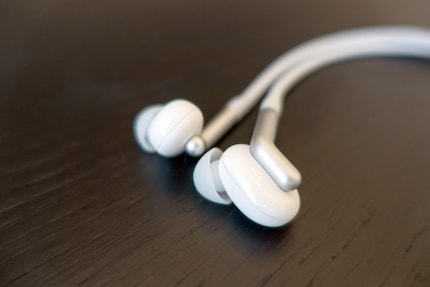
These small earphones have four different noise-cancelling levels.
Sound, silence or everything together
The sound from the Track+ is very nice and well-rounded. Only the bass should be a little more present in my ears. In the Libratone app here for Android and there for iOS, you can change the sound a little with three equaliser presets. I used the preset with extra bass and was more satisfied with it. In general, I found the sound of the headphones to be fuller - but not booming, rather with a pleasantly powerful sound.
Until now, I've always had a little trouble with headphones that use a lot of noise cancelling. Like the Sony WH-1000XM3, for example, which felt like the sound was floating away. It's completely different with the Track+. Even at the highest of the four levels, I find the sound consistently pleasant. The fact that the noise cancelling can be adjusted to different levels is particularly pleasing. However, Libratone's predecessor headphones, the wired Q Adapt in-ear, can already do this. In the app, Libratone shows you what the four levels mean:
- Ambient Pass Through, +6 dB: This lets you hear your surroundings alongside the music
- Low Noise Cancellation, 0 dB: According to Libratone, this level is best in windy conditions. I tried it while cycling and have nothing to complain about
- Moderate noise cancellation, -12 dB: The clattering, mechanical keyboards of my colleagues in the open-plan office still get through, but otherwise I can't hear much else
- Maximum noise cancellation, -23 dB: In the office, I can no longer hear the conversations of the people sitting next to me. And on a noisy bus, I can only hear my music
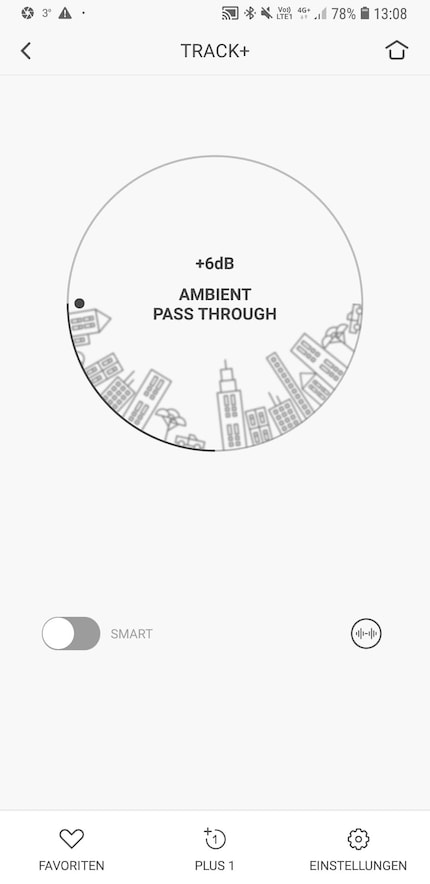
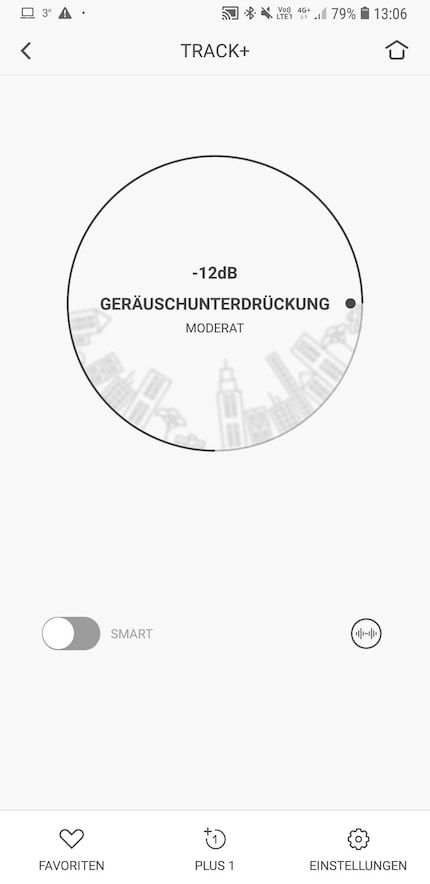
The bare decibel numbers in the app don't make much sense to me. On the Libratone homepage you can find clearer information about the noise cancelling levels:
-At level one, you can still hear 80% of the noise
-At level two it is 60%, which corresponds to the passive reduction you have when you have the headphones in your ears
-At level three, you can still hear 30% of the ambient noise
-At level four, you hear less than 10% of the noise
However, this figure is still abstract. The difference is best seen when listening. There, the different levels make sense and can be easily distinguished.
With noise cancelling activated, I don't feel comfortable walking through the city and listening to nothing but music. The risk of being run over by a bus or tram is too great for me. To solve this problem, Libratone, like other manufacturers, relies on options that allow the noise to get through. You can either simply listen at the first noise-cancelling level or activate Libratone's CityMix Smart option. With this option, the software analyses your surroundings with the microphones and then adjusts the noise cancellation. I find Libratone's Citymix quite okay. With other manufacturers, such as the Beoplay E8, I have always found such options to be artificial. This was not the case with the Track+.
Controls: also okay for Apple?
The back of the Track+ box clearly states: Made for iPhone / iPod. The controls are kept nice and simple to meet Apple's requirements: You can adjust the noise cancelling with the small left button on the elongated control. A double tapping signal lets you know when you have reached the lowest level when clicking through.
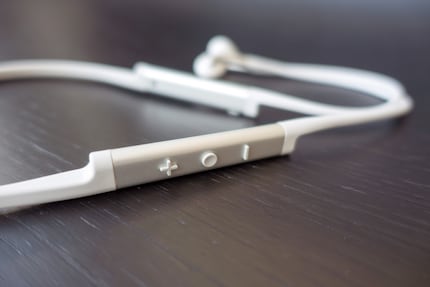
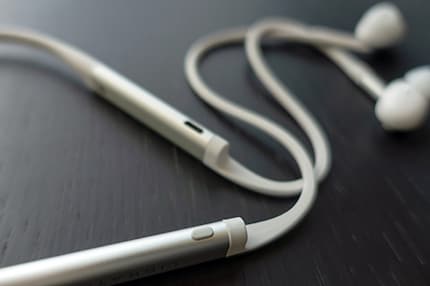
On the right-hand side, you have two volume controls with a small button in the centre. Pressing it once pauses the music, pressing it twice plays the next song and pressing it three times in succession plays the previous song. So far so simple.
The only thing I wonder about Apple's certification: the Track+ transmits with the Bluetooth codec aptX. But Apple transmits with AAC. With an iPhone, you can only listen to music with the Track+ using the SBC codec. SBC is the standard protocol for Bluetooth. I tested the headphones with an Android phone and was able to listen to my music with aptX codec. This gives me a fixed bit rate of 354 kbit/s. With SBC, the bit rate can drop depending on the situation - for example, if there are obstacles - so you may get poorer audio quality.
The pairing of headphones and mobile phone has always worked perfectly and quickly for me, even with the Android phone. I never had any dropouts. And there are no annoying delays when watching videos with headphones.
Hold like a glove
With cable, the Track+ weighs just 28 grams. Because they are so light, I was initially worried that these would be the kind of headphones that would constantly fall out of my ears. Fortunately, this is not the case. The Track+ fit my ears like a glove. I only use the small wings for jogging, which can be popped on very quickly. I could do without the wings, but the sound quality suffers. If the earbuds sit firmly in your ears, it simply sounds better.
What also speaks in favour of the Track+: My last headphones with a neck cable had a loud cable. This meant that whenever the cable reached the collar of my jacket or anywhere else, I could hear it in my ears. You won't hear the Track+ cable. And it feels warm and fine on the back of your neck.
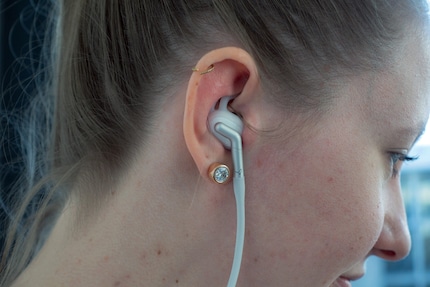
The small white dividers provide even more grip.
If you want to jog in the rain, you can do so with the Track+. It is IPX4-certified, which means it is protected against splashing water. In my case, it even survived a fall into a half-full teacup without damage.
Conclusion: lightness that pays off
The Track+ impresses me. I only noticed very few negative things in the entire test: the running time, which fluctuates slightly, and the lack of a case.
The headphones are nice and light and fit so well in the ears that you hardly notice them when wearing them. I think the price is reasonable for the performance that the Track+ delivers. The Track+ is so versatile that you don't need extra sports headphones, for example. For jogging, travelling by train, in the office or studying, they have always worked for me.
Testing devices and gadgets is my thing. Some experiments lead to interesting insights, others to demolished phones. I’m hooked on series and can’t imagine life without Netflix. In summer, you’ll find me soaking up the sun by the lake or at a music festival.



